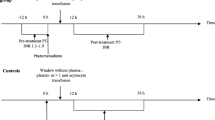Abstract
Objective
To determine prophylactic role of single dose of vitamin K in prevention of antibiotic induced hypoprothrombinemia.
Methods
This prospective comparative study included critically ill children in age group 2 mo to 12 y, admitted to a tertiary care hospital in India, likely to receive prolonged antibiotic therapy. One hundred twenty children, 60 in each group (A & B) were enrolled in the study. Patient allocation was done on alternate basis. Group A children received prophylactic vitamin K while group B did not. Baseline coagulation studies and other investigations were done in all children. Coagulation studies were repeated on day 10 and day 14 of antibiotic therapy and in between if required clinically. Children who developed deranged INR were given therapeutic vitamin K. If deranged INR returns to normal at 12 h of vitamin K administration then it indirectly confirms vitamin K deficiency. Analysis was done by fisher's t test and chi square test.
Results
In children on prolonged antibiotic therapy, vitamin K deficiency was a common problem (15 %). It was common in male sex, severe grade of protein energy malnutrition (PEM), N-methylthiotetrazole (NMTT) group containing antibiotics use and duration of antibiotic more than 10 d. It was same in children whether they received or did not receive prophylactic vitamin K on day 1 of antibiotic therapy (95 % CI; p value 0.79).
Conclusions
Vitamin K deficiency is common problem in patients on prolonged antibiotic therapy. There is no role of single dose of prophylactic vitamin K in preventing antibiotic induced hypoprothrombinemia.
Similar content being viewed by others
References
Warner ED, Brinkhous KM, Smith HP. Bleeding tendency of obstructive jaundice: prothrombin deficiency and dietary factors. Proc Soc Exp Biol Med. 1939;37:628–30.
Waddell WW Jr, Guerry III DP, Bray WE, Kelley OR. Possible effects of vitamin K on prothrombin and clotting time in newly-born infants. Proc Soc Exp Biol Med. 1939;40:432–4.
Kark R, Lozner EL. Nutritional deficiency of vitamin K in man. A study of four non-jaundiced patients with dietary deficiency. Lancet. 1939;2:1162–4.
Dam H, Tage-Hansen E, Plum P. Vitamin-K lack in normal and sick infants. Lancet. 1939;2:1157–61.
Dam H, Dyggve H, Larsen H, Plum P. The relation of vitamin K deficiency to hemorrhagic disease of the newborn. Adv Pediatr. 1952;5:129–53.
Nicholas RL, Wilker MA, Mcdevitt JT, Lentnek AL, Hosutt JA. Coagulopathy associated with extended spectrum cephalosporin in patients with serious infections. Antimicrob Agents Chemother. 1987;31:281–5.
Kliegman RM, Stanton BF, Geme III JW, Schor NF, Behrman RE. Nelson textbook of paediatrics. 19th ed. New Delhi: Elsevier publication; 2011. p. 209–10. Chapter 50,vitamin K.
Lipsky JJ. Mechanism of the inhibition of the gamma carboxylation of glutamic acid by N-methylthiotetrazole containing antibiotics. Proc Natl Acad Sci U S A. 1984;81:2893–7.
Welage LS, Hejmanowski LG, Wilton JH, Walawander C, Rigan D, Williams JS, et al. Comparison of N-methylthiotetrazole disposition in healthy volunteers following single intravenous dosages of moxalactam, cefoperazone and cefotetan. Antimicrob Agents Chemother. 1989;33:857–61.
Conly JM, Ramotar K, Chubb H, Bow EJ, Louie TJ. Hypoprothrombinemia in febrile neutropenic patients with cancer: association with antimicrobial suppression of intestinal microflora. J Infect Dis. 1984;150:202–12.
Human vitamin and mineral requirements. Report of a joint FAO/WHO expert consultation. Bangkok, Thailand: FAO/WHO; 1998.
Nutreint reference values for Australia and New Zealand including recommended dietary intakes [internet]. NHMRC publications; 2006. Available from: http://www.nhmrc.gov.au/guidelines/publications/n35-n36-n37.
Nathan DG, Orkin SH, Ginsburg D, Look AT. Hematology of infancy and childhood. 6th ed. Philadelphia: W.B. Saunders company; 2003. Appendices;p.1853
Hypoprothrombinemia workup. [internet]. Available from: http://emedicine.medscape.com/article/956030-workup
Matschiner JT, Bell RG. Effect of sex and sex hormones on plasmaprothrombin and vitamin K deficiency. Proc Soc Exp Biol Med. 1973;144:316–20.
Bhat RV, Deshmukh CT. A study of Vitamin K status in children on prolonged antibiotic therapy. Indian Pediatr. 2003;40:36–40.
Ehsanipour F, Zarifian D. Study of coagulopathy and its risk factors in children on prolonged antibiotic therapy admitted into Rasoul-e-Akram hospital. Razi J MedSci. 2002;47:11–7.
Pineo GF, Gallus AS, Hirsh J. Unexpected vitamin K deficiency in hospitalized patients. Can Med Assoc J. 1973;109:880–3.
Shearer MJ, Bechtold H, Andrassy K, Koderisch J, McCarthy PT, Trenk D, et al. Mechanism of cephalosporin-induced hypoprothrombinemia: relation to cephalosporin side chain, vitamin K metabolism, and vitamin K status. J Clin Pharmacol. 1988;28:88–95.
Williams KJ, Bax RP, Brown H, Machin SJ. Antibiotic treatment and associated prolonged prothrombin time. J Clin Pathol. 1991;44:738–41.
Lusher JM. Diseases of coagulation. In: Nathan DG, Oski FA, editors. Hematology of infancy and childhood. 3rd ed. Philadelphia: W.B. Saunders Company; 1987. p. 1327–8.
Usui Y, Tanimura H, Nishimura N, Kobayashi N, Okanoue T, Ozawa K. Vitamin K concentration in the plasma and liver of surgical patients. Am J Clin Nutr. 1990;51:846–52.
Barkhan P, Shearer MJ. Metabolism of vitamin K1 (phyloquinone) in man. Proc R Soc Med. 1977;70:93–6.
Olson RE, Chao J, Graham D, Bates MW, Lewis JH. Total body phyloquinone and its turnover in human subjects at two levels of vitamin K intake. Br J Nutr. 2002;87:543–53.
Conflict of Interest
None.
Source of Funding
None.
Author information
Authors and Affiliations
Corresponding author
Rights and permissions
About this article
Cite this article
Aziz, F., Patil, P. Role of Prophylactic Vitamin K in Preventing Antibiotic Induced Hypoprothrombinemia. Indian J Pediatr 82, 363–367 (2015). https://doi.org/10.1007/s12098-014-1584-3
Received:
Accepted:
Published:
Issue Date:
DOI: https://doi.org/10.1007/s12098-014-1584-3




